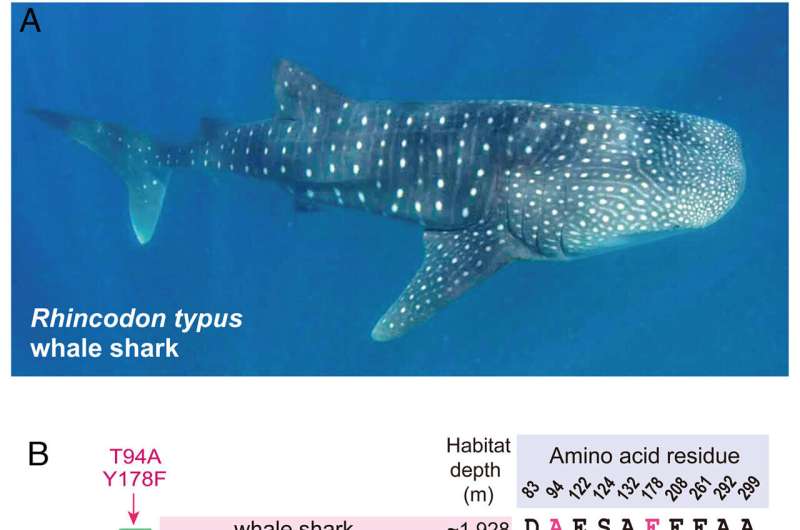March 28, 2023 report
This article has been reviewed according to Science X's editorial process and policies. Editors have highlighted the following attributes while ensuring the content's credibility:
fact-checked
peer-reviewed publication
trusted source
proofread
Temperature-dependent adaptations of whale shark vision

Researchers in Japan led by the RIKEN Center for Biosystems Dynamics Research, Kobe and Osaka Metropolitan University, Osaka, have discovered that whale shark vision has uniquely temperature-dependent adaptations unseen in any other lifeform. They have detailed the findings in a study titled "Whale shark rhodopsin adapted to deep-sea lifestyle by a substitution associated with human disease," published in the Proceedings of the National Academy of Sciences.
Whale sharks (Rhincodon typus) are the largest fish on the planet, with the longest specimen reliably measured by researchers at 61.7 feet (18.8 m). While whale sharks spend most of their time near the ocean's sunlit surface, they occasionally visit the deep sea. The deepest dive recorded by a whale shark is an impressive 1,928 meters, though it is hard to fathom why. There are other creatures that dive to great depths in search of food—for example, sperm whales in search of giant squid, or elephant seals in search of deep-sea meals. However, the whale shark primarily feeds on plankton or other near-surface snacks, so they likely dive for reasons other than the obvious "because they can."
Pressures at that depth are intense (2,800 psi or 191 atmospheric pressures), and temperatures an unchanging 39°F (4°C). Just 200 meters below the surface, darkness surrounds the deep, with the first signs of bioluminescent lifeforms. At 1,500 meters depth, the only available light comes from bioluminescent animals. Sunlight, scattered and absorbed by the water above, leaves little for the eye to detect. Many deep-sea creatures have enormous eyes to compensate, while others have abandoned ocular vision entirely.
Whale shark eyes are a strange assortment of curious adaptations. Teeth surround the iris, the eyes can retract into the skull, and they possess "blue-shifted" rhodopsin, allowing them to capture more blue light. Blue light capture is handy in deep water because blue light penetrates deeper than other frequencies. The puzzling question is: Why would a creature that spends most of its time near the surface have eyes best suited for the deep sea, eyes that would make near-surface vision worse?
Spectroscopic analysis of retinal photoreceptors uncovered the wavelength of the maximum absorbance of around 478 nm. Light of approximately 480 nm is the most available in the deep sea environment, suggesting the reliance on whale shark vision in the deep sea was a form of photoreceptor tuning. This tuning has been seen in other sea creatures, but the mechanism in the whale shark seemed to be different.
Researchers scrutinized the sequence alignment of the photoreceptors in comparison to their closest shark relatives. This analysis revealed two amino acid site changes, substituted exclusively in the whale shark and no substitutions at previously characterized spectral tuning sites. Whatever the whale shark eye was doing was different from what had been seen elsewhere. The researchers found retinal photoreceptors with multiple mutation strategies, one of which is linked to night blindness in humans.
One of the substitution variants was found to be primarily responsible for a shift to the blue light spectrum. A comparable variant in humans leads to a condition called congenital stationary night blindness, where vision is severely impaired in low-light situations. This variant also was found to be thermally unstable, meaning it could be degraded by temperature. It would be an interesting follow-up to test afflicted humans for low-light deep sea visibility at near-freezing temperatures, though the participants may find this less than helpful.
In a separate variant location, the whale shark eye pigment was again thermally activated toward instability, in this case, attuning for longer wavelengths.
Alone, these thermally unstable gene pigments might be considered a hindrance to vision. However, as the researchers discovered, the combination of the two enhances overall vision stability and allows whale sharks to see the world from different perspectives as environmental light conditions change.
More information: Kazuaki Yamaguchi et al, Whale shark rhodopsin adapted to deep-sea lifestyle by a substitution associated with human disease, Proceedings of the National Academy of Sciences (2023). DOI: 10.1073/pnas.2220728120
Journal information: Proceedings of the National Academy of Sciences
© 2023 Science X Network





















